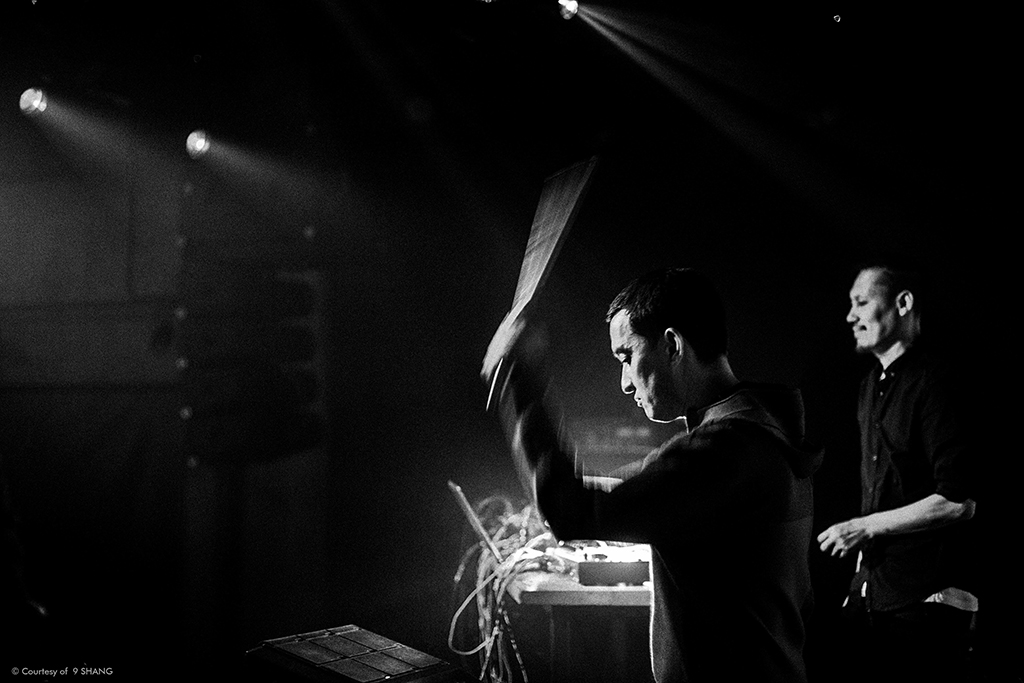
17+Band Cooperation, YUE SPACE, Beijing on 10 April, 2019; Photo by 9SHANG
On the evening of February 29, 2020, a “Voluntary Garden” online concert co-presented by UCCA x Kuaishou has initiated an unprecedented cross-temporal relay of music. This special live music broadcast during the pandemic of COVID-19 did not just encourage those who are concerned about art but have to stay at home; it has also extended more possibilities for future art using artists’ imagination. As the initiator of “Voluntary Garden”, Mr. Colin Siyuan Chinnery although felt regret as the performance and seminar could not be put on as scheduled, he also regarded this period of “quiet isolation” as a chance that he could sort out his creations, think and establish a platform where he can share sound art and interact with others. From a “Kungfu boy” to a contemporary sound artist, Mr. Colin Siyuan Chinnery who has been inextricably linked to China since his childhood, shifted the focus of his work and life to Beijing from 2002. Imperceptibly, he becomes a participant and witness of avant-garde contemporary art in China. CAFA ART INFO conducted a special interview with Mr. Colin Siyuan Chinnery focusing on the sound art that he has been engaged in, and he reviewed the history of contemporary Chinese art over the past two decades from his perspective.
Interviewee: Mr. Colin Siyuan Chinnery
Interviewer & Editor: Sue Wang
Interview Date: March 6, 2020
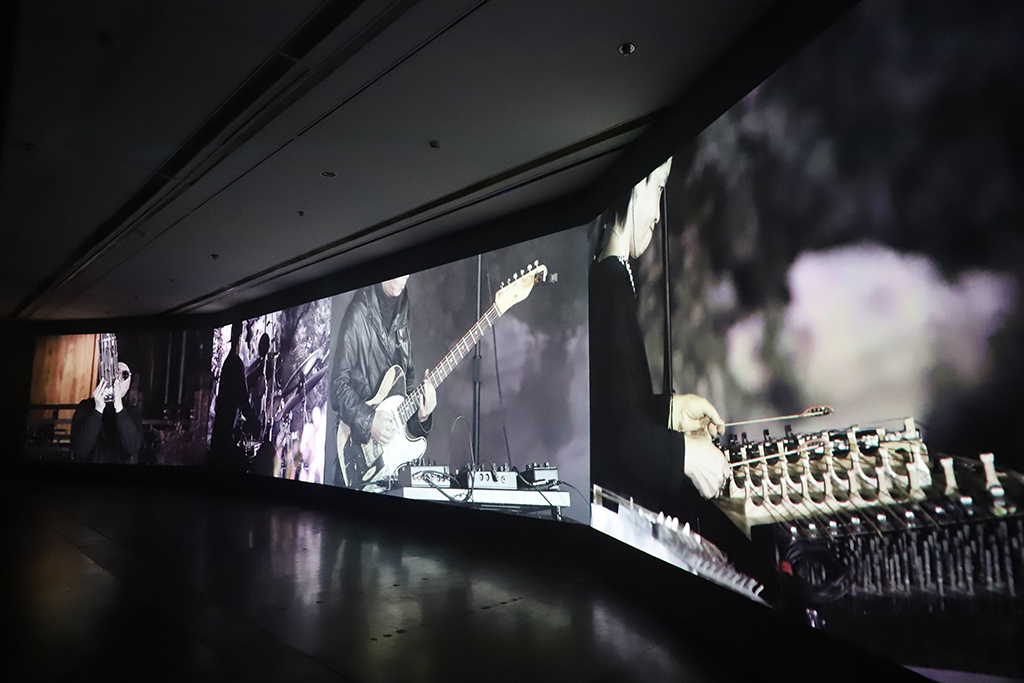
“Voluntary Garden” at UCCA Photo by Mr. Colin Siyuan Chinnery
CAFA ART INFO: As a cross-cultural sound artist, your personal experience is so rich that there has been a report stating that you “know the world better than the Chinese, and you have a better understanding of Chinese culture than foreigners.” Let’s start with sound art. What was your original intention in collecting sound? When did you collect your first sound? What was it about? What did it mean to you?
Mr. Colin Siyuan Chinnery: As early as 2005, I did a project entitled “Sound and the City”. This was my first project and it had a great influence on me. Sound seemed to be an alien media at that time, but the social response of that project was quite thought-provoking. This project involved so many voices in ordinary life, but this common voice can also serve as a bridge between personal experience and history, society and culture. I started to work on sound art since preparing a project for Shijia Hutong Museum. At that time, the museum intended to present life in old Beijing, but had not yet determined a specific theme. As I have experience in this field, I suggested that if it was on old Beijing, sound could be interesting. As I had recorded materials for the project of “Sound and the City”, I came up with the idea of using sound to present the history of Beijing. As there are many restrictions here and there are many difficulties in implementation, I can only realize my ideas by using traditional culture in Beijing before 1958 or from after China’s opening-up of 1979. Most of China’s modern history cannot be touched, so my initial ideas couldn’t be done. I started with the old culture in Beijing, so I recorded sounds of itinerant traders. This was the start of my work on sound.
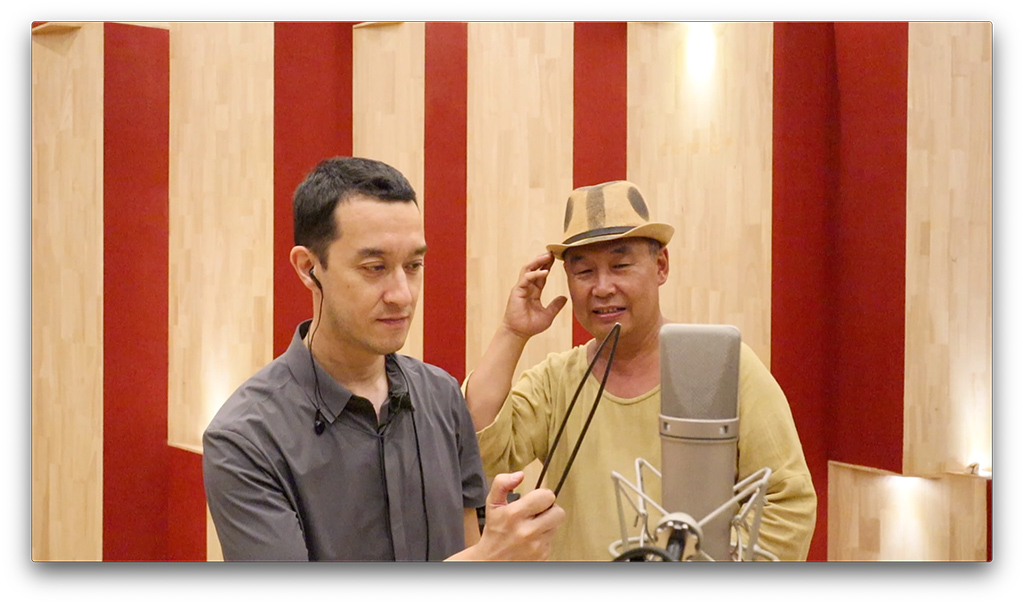 Mr. Colin Siyuan Chinnerydid recording with Along, a collector of old Beijing items in 2018, Screenshot
Mr. Colin Siyuan Chinnerydid recording with Along, a collector of old Beijing items in 2018, Screenshot
CAFA ART INFO: Your sound booth at the Shijia Hutong Museum (2013-) is one of your representative projects and has attracted a lot of attention at home and abroad. Is it difficult to promote such non-profit projects? Are you still working on similar non-profit projects? Another project, entitled “Hawker’s Refrain”, has been collected by Beijing Fun. Are you working on similar public sound projects?
Mr. Colin Siyuan Chinnery: This year, we will update the content and equipment of the project at the Shijia Hutong Museum. I will also continue with other projects but they will not be called “Sound Museum” any more. As “Sound Museum” might easily lead to a misunderstanding, as what I do does not belong to the remit of a museum. My core identity is as an artist and I do personal projects, unlike a real museum supported by the government or a public fund that needs to collect and classify their contents into a formal archive. I have not encountered any particular difficulty and I have just worked on individual projects one by one. Beijing Fun wanted to work with some Chinese and foreign artists to create public art there, as Dashilan was originally a commercial center of old Beijing and it was very prosperous before liberation, but it later became very rundown. When I received this commission, I had collected a lot of sounds of itinerant trading culture in Beijing, including sounds of street hawking, sounding instruments, pigeon whistles and so on. Thus I thought I could use these sounds to form an environment there. Public art is not easy to make, as it is for a general public, unlike visitors to exhibitions in art museums who know what to expect.
I went to Litang last year for another project, it is in the Sichuan-Tibet area, and they needed to make sound recordings of their local culture. Because I am recording disappearing sounds, I think they still have a traditional way of life, especially the life of herders and their religious life. They have a very close relationship between tradition and nature, which is of great value.
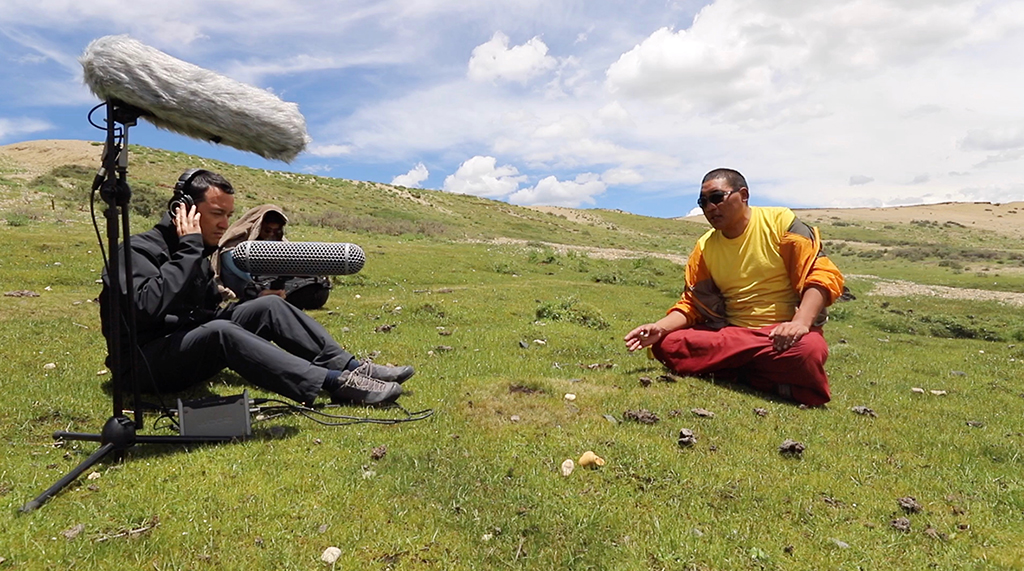
Mr. Colin Siyuan Chinnery collected the performance sound of Luorongjiacuo who is a performer of Tibetan Drama at Litang, Screenshot
My current project is called “Sound Terminus” and it can be taken as a new site for myself. I have planned a multifaceted project near Chengdu, which includes many aspects of sound art. As the coronavirus spread, this project had to be postponed. I have also used the sounds of old Beijing I collected to collaborate with electronic musician Huang Jin for music work: “Hawker’s Rhythm”, we have performed it three times, the first time was at Today Art Museum and the second time at the opening of the David Hockney exhibition at the M WOODS Hutong, the third live performance was conducted upon the release of the new music platform “Sound China”. Combining with sounds of Beijing sounding instruments, we’re exploring how to create contemporary music with old heritage sounds. We will expand this project into an album later this year.
Gradually I will continue to expand the concept of sound in the next few years. Much of my previous work was related to old Beijing, because I live in Beijing and I find that there’s no one doing this type of work here yet. Since I have started, I should finish the work. Therefore I have found some people who were actually engaged in hawking before 1949 though there is only one person still alive, Mr. Yang Deshan, who I have recorded several times. There are a lot of sound that are disappearing now, including the culture of bird keeping in China. It’s illegal to raise any wild animals now, it’s also illegal to capture or keep wild birds, and trading is completely forbidden. When these bird keepers passed away, this culture will disappear. People who used to play in the park are confronted with more and more regulations, so that they have less and less space to play their hobbies.
These disappearing sounds are not just a issue in Beijing, there is no difference across the country. A sound project like the one I made for Beijing Fun is easy to understand, and related to both past and present. I’d like to explore this kind of sound installation and public art in various cities, I hope there are some sounds projects combined with local traditional culture that I can be involved in during the future. My public art project encourage the interaction between sounds and the city, and technology can make it easier to create and present. Therefore I hope I can expand it from Beijing to the whole country. My recent project at UCCA, “Voluntary Garden” is a contemporary art project. Taking music as sound material, I have made collages with it and transformed it into another kind of music. It can be regarded as music or sound art, but basically it’s an artwork.
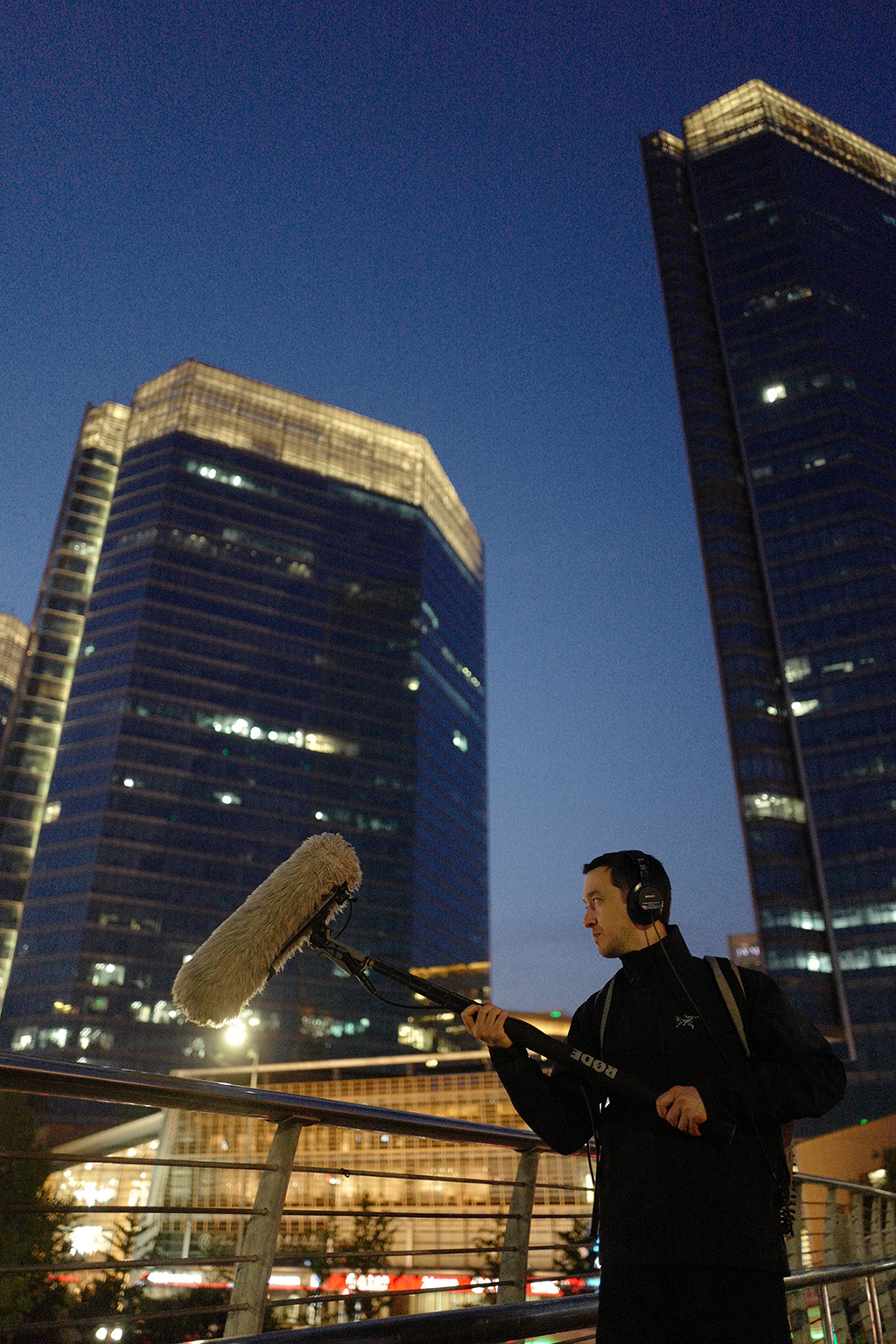
Sola-Hearing Old Beijing, Photo by Sola
CAFA ART INFO: You once mentioned that “sound is like smell as it can trigger emotions and memories, which might be currently called a “transcending” feeling. You hope that people can interact with society with sound works, what kind of interaction do you mean? What impact do you expect from this interaction?
Mr. Colin Siyuan Chinnery: I have a project under discussion, which is about the sounds of the 1980s. The process of collecting such sounds will be quite difficult, I don’t have any material at hand, which means I need to collect materials from society. I want to collect them through social media. I am also building a website through which other people can upload their own recordings. I want to communicate with a wider society through the Internet. I would like to ask people whether they have memories about the sounds in the 1980s. Do their parents and family have any memories. This topic will be open to all and hopefully online responses and discussions will allow me to identify lots of specific sounds to record. This kind of social interaction can only be realized through online communication, awakening memories of the 1980s, especially the specific details of life, then I will see what kind of interesting sounds can be further discussed.
I’d like to slowly conduct the process of sound recording, what I have done is far from enough, so that I feel that if I can explore wider, I will gradually get more interesting ideas. This is the point of it for me. If my work gets narrower and narrower then there won’t be any point to it. Right now, I feel that my ideas are broadening out, so I am optimistic about my future projects.
 Portrait of Mr. Colin Siyuan Chinnery, Photo by Zhang Chi
Portrait of Mr. Colin Siyuan Chinnery, Photo by Zhang Chi
CAFA ART INFO: Did you also stay in Beijing during the SARS period in 2003? How were you at that time? In the Spring Festival of 2020, the spread of new coronavirus pneumonia in China, has influenced other countries in Asia and Europe…when the epidemic occurred, were you in Beijing? Does it affect you? How do you proceed with your work? Does the epidemic present any new implications for you compared to SARS? How are your friends and work partners around you?
Mr. Colin Siyuan Chinnery: Of course, I am worried about the spread of the epidemic. I’m not terribly worried about myself. As long as I protect myself by social distancing and disinfecting, there shouldn’t be a problem. But you can’t control the unexpected, which is scary to find out afterwards. In terms of my own work, although the show was cut short, I thought it important to be proactive. We originally had two more performances to do at UCCA. Simply cancelling them would be negative and unimaginative. Therefore, UCCA cooperated with Kuaishou on a live streamed concert (February 29th). Originally, my exhibition ended on March 1st, so it was good to have such a performance just the day before the end of the exhibition. In the end, special guests such as Sakamoto Ryuichi, Peng Lei and Pang Kuan of the New Pants Band participated. They were not artists of “Voluntary Garden", but they were willing to participate and took it very seriously. So what was originally negative became very positive. Also the online concert attracted far more attention than ordinary concerts, so this positive response was also rewarding.
In addition, at the beginning of the epidemic, I was also preparing my personal website to announce my latest developments. I was also setting up my "Sound Terminus" platform. Usually these tasks were boring. It was difficult to do these repetitive tasks without a special period. It is the perfect moment to do them, and I plan to launch my website in April. Most friends around me are artists. Many people's projects will be postponed for the time being. In fact, it is still a good time to sort materials and think about different perspectives.
I had just been in Beijing for one year in 2003. At that time, I was not particularly nervous. Although the mortality rate was much higher than now, the transmission rate was far lower. I don't seem to remember wearing a mask, just remember washing my hands and cleaning surfaces a lot. I knew about the SARS outbreak well before it was officially recognized. At that time, information was not circulated very quickly. The most affected people were medical staff. At that time, we didn't feel in danger.

Colin Chinnery (IDP) making a presentation on IDP to the Chinese Minister of Culture, Sun Jiazheng, and his delegation,
The British Library, 17 October 2000 ??British Library
CAFA ART INFO: You mentioned before that your childhood memories of Beijing were “grey” and people were not very energetic…You have been settled in Beijing since 2002 and now both material and spiritual life seem to be richer in Beijing, what do you think of the significant changes in Beijing’s contemporary art environment and artist community over the past decade?
Mr. Colin Siyuan Chinnery: The most significant change is increase in material living, but spiritually it might be weaker. The contemporary art system has become a lot stronger, with new private art museums, commercial galleries, art fairs, etc. However, it relies heavily on the art market, and the non-profit sector is still rather weak. The content side used to have more variety, but it has become rather predictable recently. So this is not a situation that simply improves over time. In fact, I think content wise it’s perhaps more limited than before. In the past, we had less money and more ideas. Now the system is bigger, but there are more restrictions. Therefore, the current art system is relatively commercial. This situation is not particularly conducive to the emergence of very good artists. Unlike earlier artists who didn’t have a market to think about, they only had to try to make better or more adventurous work than other artists. Young artists now are very skilled and versatile, but they’re more likely to use readymade formal languages rather trying to invent their own.
CAFA ART INFO: Currently, there is a pessimistic opinion that, for the impact of this pandemic, many exhibitions and art expos have been suspended or cancelled, some galleries or art institutions are been confronted with operational difficulties…but after the pandemic, there might be a boom of exhibitions on the one hand, but on the other hand it might not stimulate the growth of the art market, thus it might exert some negative influence on the art ecosystem. What do you think of these predictions?
Mr. Colin Siyuan Chinnery: I'm not so pessimistic, I think that the Chinese art ecology is particularly active, on the one hand you also feel that there are actually many problems behind it - I just mentioned the materialization phenomenon ... now there is also the effect of the epidemic. At the beginning, it will be difficult for everyone to adjust, especially the small galleries that don't have a lot of capital. However, I hope that the ecology will change through such influence. Because before the economic crisis in 2008-2009, the Chinese art market was very problematic. There was a lot of collusion between artists, collectors, and auction houses to artificially inflate artists’ prices. A lot of very bad artists made a lot of money. It was very rough and poor market behavior. Most collectors at that time had nothing to do with collecting. They just saw the opportunity of manipulating an unregulated market. The real estate market was already being controlled, so they sought out another “l(fā)awless” market. The art system was weak at that time, and the speculative groups had a lot of clout. After the economic crisis, the bubble was burst and speculators disappeared. Later, many young collectors returned from abroad and began to make things happen. A lot of serious artists and a lot of new magazines and publications, new private art museums emerged and they reconstituted the art ecology from that time, so it was much healthier than before. Whether this epidemic will have the same effect now, we don't know yet, but I hope this epidemic will have some positive effect. Although it’s going to be difficult for many people, things might change for the better after the epidemic, but probably in a very different way compared with 2008-2009.
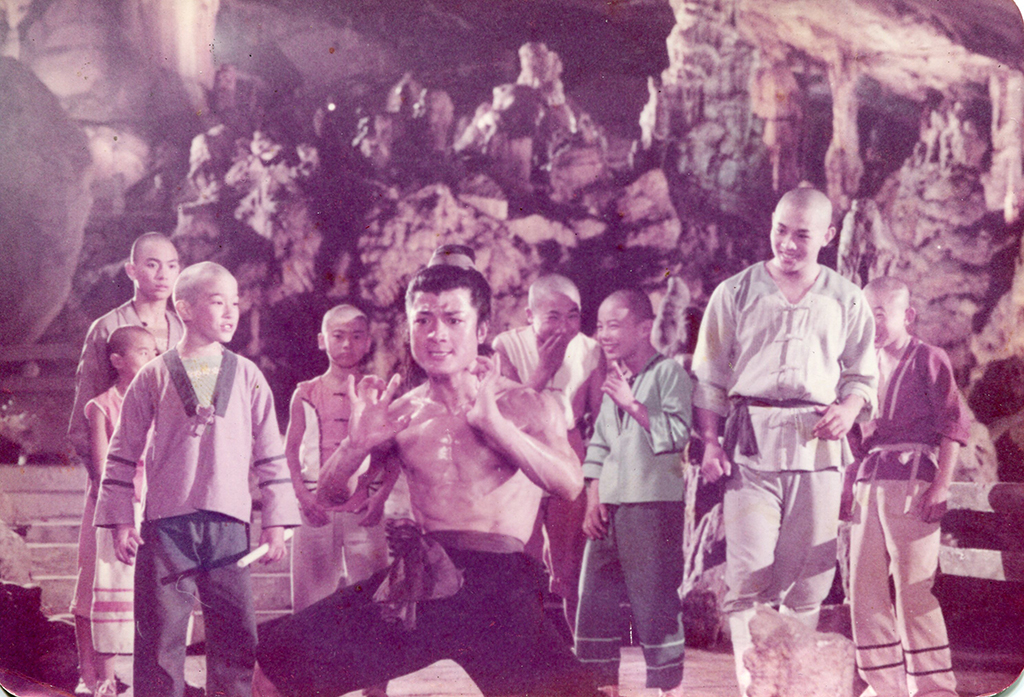
“Kungfu boy”, Stage Shot, Mr. Colin Siyuan Chinnery stood on the left holding a scroll
CAFA ART INFO: You once used “complicated” to summarize your “unprecedented” experience. You were born into a intellectual family, you have learned martial arts, you were a lead singer in a rock band and you used to work as a researcher…Now you are a sound artist and curator, how do you position yourself now and plan your future work?
Mr. Colin Siyuan Chinnery: I have stopped my individual curatorial activities. I am working on my Sound Terminus platform, which includes art projects, cultural projects, and curatorial projects. Unlike my previous curatorial work for museums and galleries, all my curatorial activities will be under the remit of Sound Terminus. This is a versatile platform that will explore all kinds of directions, both non-profit and commercial. I also work for the Beijing non-profit art space The Bunker. Our team functions like a group or collective. We are all volunteers, and each of us have specific tasks. My responsibility is to run the exhibition program.
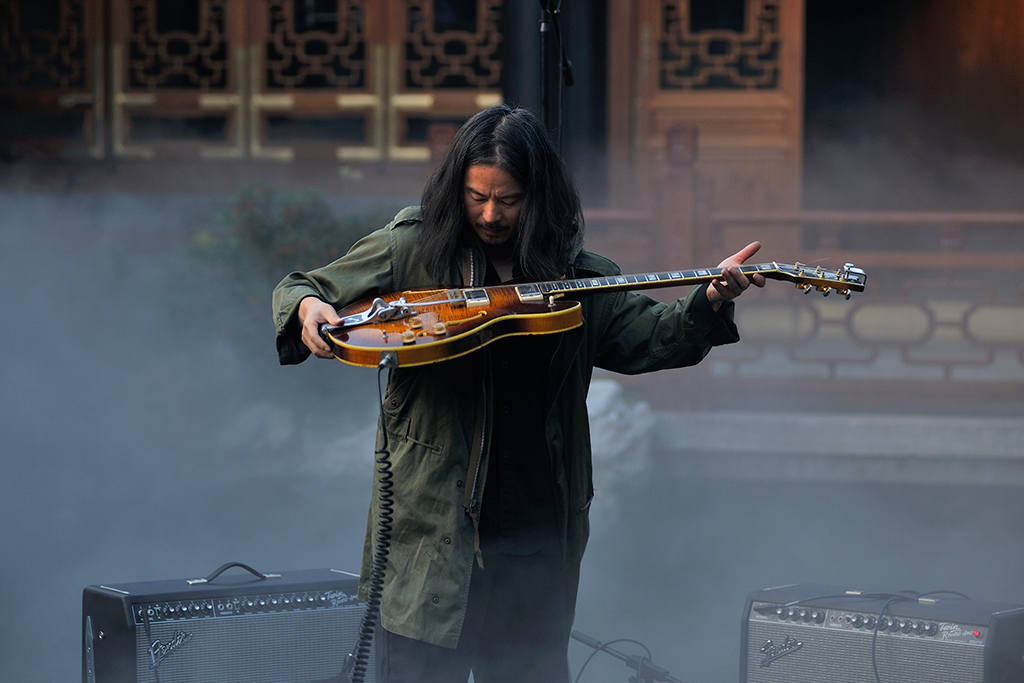
“Voluntary Garden”, Performance by Li Jianhong at Fusion Art Center, Photo by Song Xiaohui
CAFA ART INFO: “Voluntary Garden” exhibition and performance project (2019.12.12-2020.3.1 Fusion Art Center, 2019.12.12-2020.03.01 UCCA), is a project that you invited musicians to who have not collaborated before or may have never even met, they come together to improvise on stage, despite only having the shared contact of “playing” together in the musical piece edited by you. Then you deconstruct and reorganized the video and sound, creating sound art and video installation works. From “collecting sound” to “creating sound”, what do you think of the experimental significance in this project? What do you expect from it? Another version of “Voluntary Garden” was presented as a live show on Kuaishou, maybe it’s the first time for it to be performed as a live broadcast, will you reedit the video and create video installations later in various forms? or with new elements?
Mr. Colin Siyuan Chinnery: I hope this work will tour to various cities and countries to face different audiences. It is not a work that people have difficulty in understanding or appreciating. Through the work itself I have met many good musicians and made a lot of new friends. I have also learned a lot from the whole process of doing the project, which is motivating me to generate new ideas for the future. Wherever this exhibition will be presented, there will definitely be performances. Also, I hope that this work can be exhibited abroad and the Chinese musicians will form new dialogues with local artists and generate new ideas. Still, I don’t know how my work will continue in the future.
CAFA ART INFO: Sentiment and insight are the most important elements for art, as a cross-border and cross-cultural artist and experienced curator, how do you interpret the development of contemporary art in China? Would you like to offer some suggestions to young artists?
Mr. Colin Siyuan Chinnery: There’s a saying in China that “know thyself and know your enemy”, many artists first learn about others, i.e. other artists, the system, etc., but they have not begun to know themselves. Both of the aspects should be carried out simultaneously. Otherwise, the art that an artist creates has nothing to do with himself and therefore can’t develop any true relevance. Whether it is an imitation or flirting with the zeitgeist, all art must stem from the artist.
Photo Courtesy of the Artist and Related Organizations.
Note: The views and opinions expressed in this interview are those of the interviewee and do not necessarily reflect the official policy or position of CAFA ART INFO and its employees.




























